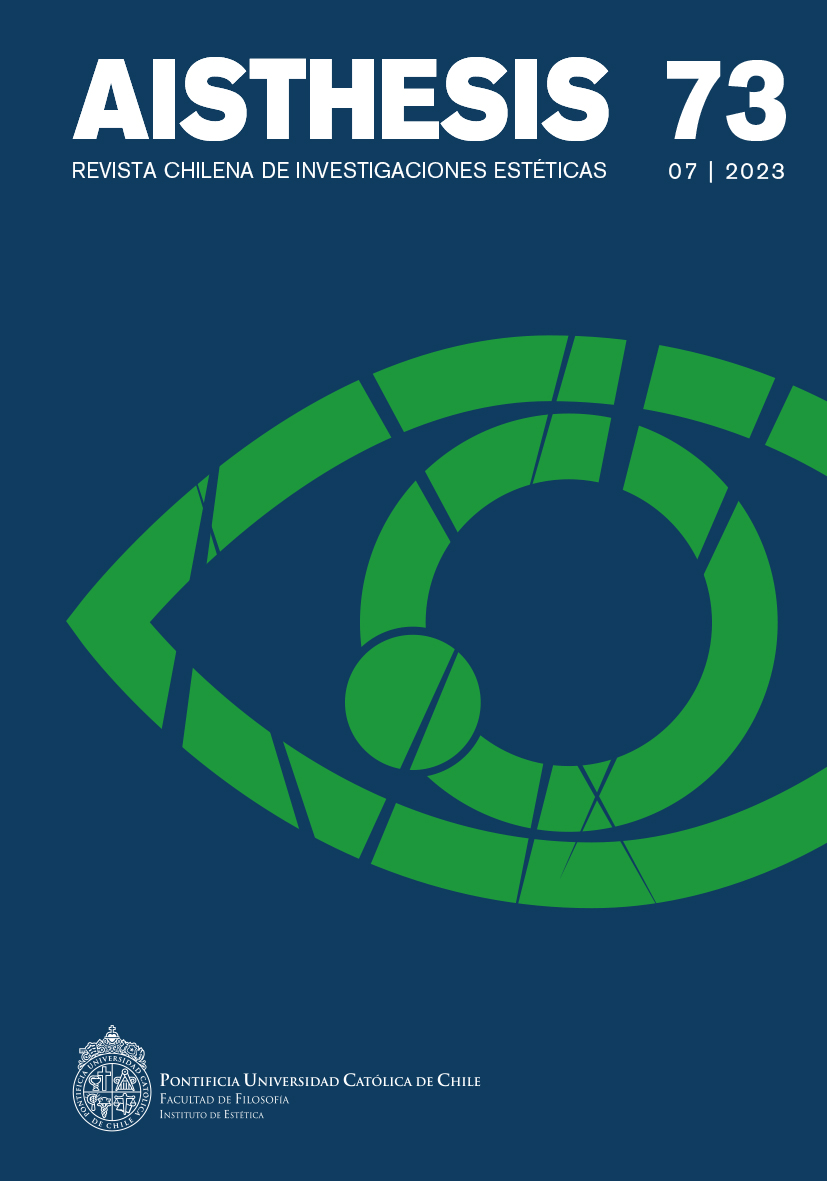Dystopian Aesthetics in the Painting of the Cuban Artist Vicente Hernández: The Eye of the Storm
Main Article Content
Abstract
Dystopian narrative has been widely exploited in the field of literature, in contrast to the attention received in the field of visual arts. In relation to this, the purpose of this essay is to highlight, from a critical perspective on the Cuban socio-cultural reality, the characteristic elements of dystopia in Vicente Hernández’s pictorial work through the analysis of four representative paintings of Cuban artist’s dystopian aesthetics.
Downloads
Article Details

This work is licensed under a Creative Commons Attribution-NonCommercial-ShareAlike 4.0 International License.
All contents of this electronic edition are distributed under the Creative Commons license of "Attribución-shareAlike 4.0 Internacional" (CC-BY-SA). Any total or partial reproduction of the material must mention its origin.
The rights of academic works published in this publication belong to their authors., who grant to AISTHESIS: Revista Chilena de Investigaciones Estéticas the license for its use. The management of the permits and the authorization of the publication of the images (or of any material) that contains copyright and its consequent rights of reproduction in this publication is the sole responsibility of the authors of the articles
References
Acosta, Rinaldo. “Ciencia ficción cubana en los sesenta: Arango, Collazo y Herrero”. Rialta Magazine, 20 diciembre 2019. https://rialta.org/ciencia-ficcion-cubana-en-los-sesenta-arango-collazo-y-herrero/
Agamben, Giorgio. The Time That Remains: A Commentary on the Letter to the Romans. Stan-ford, Stanford UP, 2005.
Berger, James. After the End. Representations of Post-Apocalypse. Minneapolis, Minnesota UP, 1999.
Bobes, Velia Cecilia. “Historia mínima de la Revolución cubana, de Rafael Rojas”. Perfiles lati-noamericanos, 24(48), 2016, pp. 319-325. https://perfilesla.flacso.edu.mx/index.php/perfilesla/article/view/736
Brooks. Darío. “Qué fue el ‘Período Especial’ de Cuba y por qué su gobierno teme que vuelvan ‘los difíciles momentos’ para la economía”. BBC News Mundo, 16 de abril de 2019. https://www.bbc.com/mundo/noticias-america-latina-47941889
Carpentier, Alejo. El reino de este mundo. Madrid: Alianza, 2012.
Deleuze, Gilles y Parnet, Claire. Diálogos. Valencia, Pre-Textos, 1997.
Didi-Huberman, Georges. Peuples en larmes, peuples en armes. L’œil de l’histoire 6. Paris, Mi-nuit, 2016.
Diéguez, Ileana. “¿Qué cuerpos importan?”. Rialta Magazine, 29 noviembre 2020. https://rialta.org/que-cuerpos-importan/
Domingo, Andreu. Descensos literarios los infiernos literarios. Barcelona, Anagrama, 2008.
Durant Karina. “Vicente Hernández: El místico color de las tormentas”. The Archive Cuban Art News, 01 mayo 2014. https://cubanartnewsarchive.org/es/2014/05/01/vicente-hernandez-el-mistico-color-de-las-tormentas/
Eagleton, Terry. Esperanza sin optimismo. Buenos Aires, Taurus, 2016.
Esser Helena. “Re-assembling the Victorians: Steampunk, Cyborgs, and the Ethics of Industry”, Cahiers victoriens et édouardiens, 87, 2018, pp. 1-18, http://journals.openedition.org/cve/3480
García, Luis Ignacio. “La comunidad en montaje: Georges Didi-Huberman y la política en las imágenes”, Aisthesis, 61, 2017, pp. 93-117. http://ojs.uc.cl/index.php/RAIT/article/view/2294/2294
García Navas, Mercedes. El color como recurso expresivo: análisis de las series de televisión Mad Men y Breaking Bad. Tesis doctoral. Universidad Complutense de Madrid, Facul-tad de Ciencias de la Información, Departamento de Comunicación Audiovisual, 2016.
Heller, Eva. Psicología del color. Barcelona, Gustavo Gili, 2004.
Hernández, Vicente. Catálogo. Lima: SLG, 2016.
Ibarra Cáceres, Anaeli. “La relación arte-política en Cuba”. Arte y políticas de identidad, 13, 2015, pp. 115-130. https://digitum.um.es/digitum/bitstream/10201/47952/1/250931-872371-1-SM.pdf
Jameson, Fredric. Archaeologies of the Future. The Desire Called Utopia and Other Science Fictions. New York, Verso, 2005.
Listfield, Scott. Página Instagram: https://www.instagram.com/scottlistfield/?hl=es
López-Avalos, Martín. “La cultura política de la vanguardia o la construcción del ethos revolu-cionario: Cuba 1952-1959”. Tzintzun, 53, 2011, pp. 75-105. http://www.scielo.org.mx/scielo.php?script=sci_abstract&pid=S0188-28722011000100003&lng=es&nrm=iso
López, Magdalena. “Utopía y distopía del fracaso revolucionario en la reciente novelística cuba-na”, TRANS-, 14, 2012. https://journals.openedition.org/trans/575
Martínez Heredia, Fernando. “Acerca de ‘palabras a los intelectuales’, 55 años después”. Tareas, 154, 2016, pp. 63-75. https://www.redalyc.org/pdf/5350/535055493007.pdf
More, Thomas. Utopia. Oxford, Oxford UP, 2008.
Moreno, Fernando Ángel. Teoría de la literatura de ciencia ficción. Poética y retórica de lo prospectivo. España, Sportula, 2013.
Mota, Erick. Habana Underguater. Barl Harbour, Atom Press, 2010.
Moylan, Tom. Scraps of the Untainted Sky. Science Fiction, Utopia, Dystopia. Boulder, Westview Press, 2000.
Orwell, George. 1984. Barcelona, Debolsillo, 2014a.
---. Rebelión en la granja. Buenos Aires, Maceda, 2014b.
Reati, Fernando. Postales del porvenir. La literatura argentina de anticipación en la Argentina neoliberal (1985-1999). Buenos Aires, Biblos, 2006.
Rojas, Rafael. Historia mínima de la Revolución cubana. México: El Colegio de México, 2015.
Saldías Rossel, Gabriel. (2015). En el peor lugar posible: teoría de lo distópico y su presencia en la narrativa tardofranquista española (1965-1975). Tesis de doctorado. Departa-mento de Filología Española, Universitat Autònoma de Barcelona, 2015.
Shaffer, Elinor. “VI. El apocalipsis secular: profetas y apocalipsistas a finales del siglo XVIII”. La teoría del apocalipsis y los fines del mundo, Comp. Malcolm Bull. México, FCE, 1998, pp. 233-260.
Vacca, Sofía. “El horror vacuí del Barroco y una artista latinoamericana”. Creación y Producción en Diseño y Comunicación, 80, 2017, pp. 149-151. https://fido.palermo.edu/servicios_dyc/publicacionesdc/vista/detalle_articulo.php?id_libro=682&id_articulo=14199
Zeki, Semir. Esplendores y miserias del cerebro. 2021. Obtenido de vislab.ucl.ac.uk: http://www.vislab.ucl.ac.uk/pdf/splendours_and_miseries_of_the_brain-es.pdf
